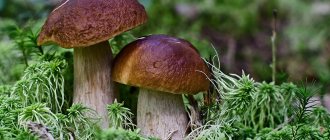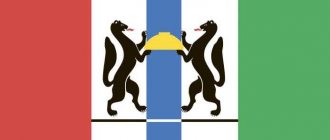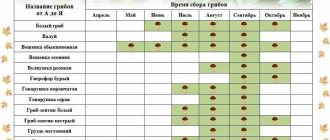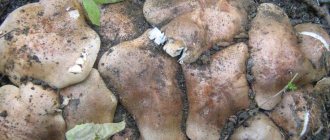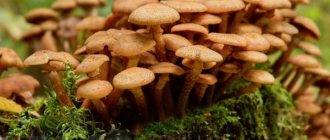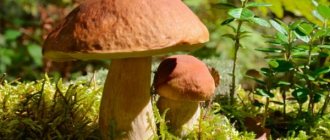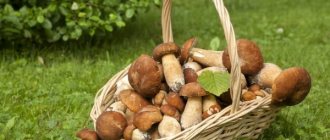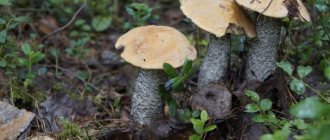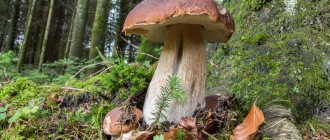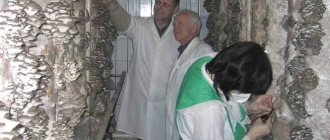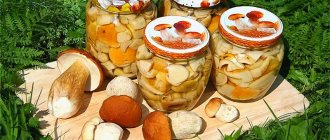Mushroom places in the Voronezh region 2022 are of interest to lovers of “quiet hunting”. Located in the south-eastern part of Russia, this area has ideal climatic conditions for the germination of mushroom species. Summers here are hot and winters are moderately cold. An impressive number of forests, a lot of reservoirs, and swampy areas, where you can also find a worthy “trophy,” also play a big role.
When compiling a general map of mushrooms in the Voronezh region, it is important not to miss the main forest plantations, meadows and forest belts of this territory. Keep in mind that when choosing an area, you need to count on certain types of mushrooms. Some are found in marshy soils, while others are found in pine or deciduous forests on sandy soils. In order not to waste time, find out in advance about all the features of a particular soil. This will allow you to know what type of mushrooms you can expect when you go mushroom picking.
What mushrooms can be collected in the Voronezh region?
Do you want to know what mushrooms are common in the Voronezh region? The forum will help you with this, as well as general information, according to which you can find here:
- pigs;
- chanterelles;
- greenfinches;
- honey mushrooms;
- Russula;
- rows;
- White mushrooms;
- a lot of boletus;
- boletus;
- lots of boletus mushrooms.
White mushroom in the Voronezh region photo
Please note that you are unlikely to find these types of mushrooms in one season. Experienced mushroom pickers know when to go for their favorites. For beginners, in order not to return home with empty buckets, it is better to go in search of a “trophy” in the autumn. But remember that the calendar period of autumn and the mushroom season do not coincide. During the mushroom period in the Voronezh region you can collect:
- a lot of porcini mushrooms;
- rows;
- russula;
- boletus;
- a lot of chanterelles;
- oily.
All these are “early” mushrooms that actively grow from the 2nd ten days of August until the last days of the first autumn month. Some even manage to “stand” until the first autumn frosts on the ground.
Edible mushrooms
Being in the Central Black Earth region, Voronezh is an ideal place for mushrooms to grow. They are found near numerous bodies of water, in forests and even swamps. Knowing the conditions in which each species grows, a mushroom picker can easily choose a search location.
Depending on the time of year, mushrooms in the Voronezh region are divided into several categories.
Spring
With the arrival of warmth, nature awakens, and among the beautiful spring greenery, starting from the end of April, you can find the first representatives of the mushroom kingdom.
Oyster mushrooms
The collection of oyster mushrooms begins in early spring. It can be found in the forest from March to April and again in autumn. It grows actively in both deciduous and mixed forests on decaying stumps.
For cooking, the pulp of the juicy gray cap, which has a characteristic aroma, is used.
The oyster mushroom has an ear-shaped shape and pronounced plates covered with a rounded edge of the cap. It reaches 8-10 cm in length. It grows in clusters. Short legs are not used for food because of their cotton-like or hard consistency.
Morels
The fungus loves rotten remains of trees, old clearings of deciduous forests and damp areas. It can be collected starting from the second month of spring, during the flowering period of apple trees.
The brown-brown porous cap is located on a light stalk, tightly fused with its edges. Its unusual appearance makes the morel recognizable, and its taste creates demand among mushroom pickers. It reaches a height of 15 cm. Although it looks voluminous, it is hollow inside. The fragile pulp has a characteristic, pronounced aroma.
Morels belong to the 3rd quality category - conditionally edible mushrooms. Therefore, before cooking, they need to be properly processed (rinsed, scalded with boiling water and boiled for 10-15 minutes). It is advisable to consume no more than 200 g of morels per day.
Morel cap
This mushroom can be found in birch and aspen forests between thickets of bushes. It appears in April. The wrinkled, elongated cap, 3 cm in diameter, is covered with a velvety coating and sits on a hollow, often curved stem, without growing to it at the edges. Its color is brown, whitish on the inside, and the leg is light interspersed with rusty spots. The mushroom grows up to 10-15 cm in height.
The second genus of morels, the representatives of which are widespread in Russia, is Verpa (Cap). The age of a morel cap can be determined by the change in color of the stem. Young fruiting bodies have lighter stems (white), but the older the mushroom, the darker the stem (yellowish with pityriasis scales). The pulp is light, waxy and thin, and has no special odor, although some mushroom pickers claim that they smell dampness. In terms of soil, these mushrooms can be called picky, because... prefer chernozem and sandstones covered with leaf litter, as well as acidic loams. Spring conditions affect fruiting. If it is cold, too damp, or, on the contrary, arid, don’t expect a harvest.
Experienced mushroom pickers recommend looking for this mushroom in 30-year-old aspen forests with a small admixture of birch, a few bushy undergrowth, lightly overgrown with grass.
Due to its appearance, the morel cap is difficult to confuse with other representatives of the Morschellaceae (Morals) family.
May mushroom
It appears in May in places not shaded by dense thickets and at the edge of the forest. Convex cream-colored caps reach 8-10 cm in diameter and are clearly visible against the background of grass. The edges are a little wavy and cracking. Thick lower plates most often grow together with a thick and lighter stalk. The texture of the pulp is dense, the color is white.
Due to the timing of the development of fruiting bodies, the mushroom is often called T-shirt, May row or St. George's mushroom. The scientific name - Calocybe may comes from the Latin name of the genus - Calocybe. According to mushroom pickers, this is one of the most delicious rows. In England, distinguished by its traditions, this St. George's mushroom (local name) is the only one that the country's population happily collects in the forests, with the exception of truffles and morels.
Honey fungus
Honey fungus prefers to grow in pastures, along the edges of forest paths and next to fields. The first mushrooms can be found in May. They can be collected in large quantities when permanent warm weather sets in. They hide in the grass and are shaped like brown umbrellas covered with a white coating.
The plates are rare, creamy. The leg has a slight yellow tint and is fragile. This species has light, watery flesh with an almond aroma and a spicy taste.
Summer
The most delicious mushrooms grow in summer
Summer mushrooms begin to grow in June. They can be found until October.
In summer the weather warms up and the nights become less cold and damp. This is the time to collect the most delicious types of mushrooms.
White
Experienced mushroom pickers look for boletuses in pine forests and spruce forests. The white mushroom got its name due to the fact that when dried it retains a white color.
The height of an adult specimen, depending on conditions, varies from 15 to 30 cm. The cap is brown, wide, up to 30-40 cm in diameter, convex. With age, it becomes flat and covered with numerous cracks. The club-shaped leg is slightly lighter than the cap.
If you find one mushroom, be sure to look around, because... Boletus mushrooms develop mycelium in the shape of a circle, which means there is a chance of finding a few more nearby.
The hunt for this mushroom continues throughout the season, because its white, juicy pulp has a delicate aroma and taste. The collection takes place from June to September.
Mycologists distinguish forms of porcini mushroom depending on the color of the cap and habitat: birch, oak, pine, etc.
Funnel talker
It is most often found in pine forests or mixed forests. There you can find it along roads going through the forest, on the edges or clearings. The collection season begins in July and lasts 3 months. This is the most common species of the genus.
The pulp has a fibrous structure and has no taste. The light brown funnel-shaped cap is attached to a thin, slightly pubescent stem. There are both small and large specimens (up to 20 cm in diameter). Light, sparse plates smoothly connect the top of the mushroom with its stem.
Red saffron milk cap
A tasty and nutritious favorite of many mushroom pickers, it grows from July to October in deciduous forests.
A beautiful dense cap of pink or orange color with a diameter of up to 15 cm has a small depression in the center and edges bent to the plates. They are densely located and are not too large in size. It got its specific epithet – red, or blood-red – due to the color of the flesh in the stalk and under the lamellar hymenophore.
The leg widens downward. Its color is almost the same as that of the cap, but there are depressions or traces of plaque on the surface. The milky juice turns the white flesh reddish.
The saffron milk cap is real
It is similar in description and size to red. Its shiny, slightly sticky cap can be either dark yellow or reddish-ochre. In a young specimen it is convex, but in an old specimen it becomes depressed, and characteristic rings and plaque appear on it. Rare plates, like the pulp, acquire a green tint when pressed or cut. The juice is light orange. Experienced mushroom pickers consider it a very valuable edible mushroom, capable of competing even with white mushrooms.
boletus
It can be found from June to October in deciduous forests with birch trees growing there. The diameter of the cap is 12 cm. Its shape is similar to a hemisphere. The pulp is white and has a dense structure. The leg reaches 10 cm in height, it is light, covered with dark scales below. Interestingly, with high air humidity, the surface of the cap becomes sticky and it becomes covered with mucus.
Champignon
They grow in meadows, clearings, parks, and gardens. Their white round cap has a convex shape, but in the old specimen it becomes like an umbrella. Depending on the species, the color of the cap can be not only white, but also brown and even brown. The surface can be either smooth or covered with scales. The records darken over time. The entire mushroom (both the cap and the dense hollow stem) is covered with small light scales. The height of the champignon is about 10-13 cm. The flesh is light, with a characteristic aroma.
These mushrooms are grown on an industrial scale.
Autumn
Autumn, with its favorable conditions and warm September rains, is considered the most successful time for collecting edible mushrooms in the Voronezh region. Lovers of summer mushrooms can again go to the forest on previously studied routes and master new ones, because... in September and October their growth may repeat.
The autumn season is rich in many varieties, but the search is complicated by the bright colors of the foliage of the trees, which, when they fall, hide them.
- Black breast: often grows in spruce forests from September to October. The dark green cap has a lighter, turned-up edge. Descending greenish plates are attached to a dense, hollow stalk. The milky juice appears white against the background of the dense pulp, but it quickly changes color to brown-violet. Fans of salted milk mushrooms need to be prepared for some difficult cleaning work when turning the mushroom into an incredible delicacy.
- Boletus: grows in oak groves and forests from August to September. The semicircular brown cap has a diameter of 16 cm. The brown leg becomes slightly thinner towards the top and has dark scales. The dense white pulp quickly darkens at the cut site, becoming first blue and then almost black.
- Russula scaly: prefers birch and oak forests. The hat is brick-colored, spherical. Over time it becomes flat. The plates are white and thick. The leg is dense, cylindrical, pale pink. The pulp is odorless, dense, white, tasty. Some types can be consumed immediately after daily salting. which gave the Russian name to this group of mushrooms.
- Autumn honey fungus: the owner of a convex small sand-colored cap. It is covered with scales and has a dark, convex central part. The stem is long, thin, with a ring at the base, fused with the entire bunch. These two signs distinguish it from false mushrooms. The tasty pulp has a pronounced mushroom taste and aroma. Honey fungus grows from late summer on stumps and decaying trees.
- Common chanterelle: grows in the forest all summer and autumn. Its funnel-shaped cap with wavy edges reaches a diameter of 6 cm. The color is yellowish. Rare pseudoplates (representing folds) on a smooth, tapered stalk have an ocher tint. The pulp is whitish, dense.
Common chanterelle has a natural, piquant bitterness in its taste, for which it is highly valued by culinary specialists and is not liked by insect larvae. If you do not process the mushrooms immediately after picking, the bitterness may increase. In addition, bitterness in taste is typical for specimens that are collected:
- under conifers;
- in hot and dry weather;
- in an industrial area or next to busy roads;
- in the moss.
Old (overgrown) mushrooms and false chanterelles can also be bitter. In order not to spoil the dish and to be confident in the quality of the collected forest gifts, it is best to pay attention to young chanterelles whose caps have not yet opened.
The pulp of chanterelles contains the polysaccharide quinomannose, which is used in the treatment of helminthiasis in humans. On its basis, the drug “Fungo-Shi - chanterelles” was created in Russia for these purposes. Herbalists very often recommend using an alcohol tincture of chanterelles to get rid of helminths (worms), because Quinomannose is destroyed already at +500C and salting.
Where to go to pick mushrooms?
Previously in Voronezh on the map of the island. These include suburban areas where there are fewer toxins in the soil. It is recommended to collect forest mushrooms only in places that have been tested and approved by locals. To avoid trouble, do not go “silent hunting” in parks and nature reserves. Prefer them to forestry.
Mushroom places in the Voronezh region 2022 are, first of all:
- Somovskoe forestry. Go north, focusing on the railway station, or east, closer to Orlov, Grafskoye and Dubovki.
- Left Bank forestry. Here you can find almost all edible mushrooms “typical” of the Voronezh region. Their diversity is guaranteed by the moist soil of the pine mixed forest, as well as by the good state of the ecology.
Foresters told where to pick mushrooms in the forests near Voronezh (MAP)
The most mushroom time has begun in the Voronezh region. In August and September, you can make a year's supply of dried and salted mushrooms, and also get the unforgettable pleasure of a quiet hunt. This year in July, the foresters assure, the “mushroom fishing” was a success - there are quite a lot of boletuses, aspen boletus, boletus, boletus and other gifts of nature with caps. Many people show off their “trophies” on social networks. So one of our readers sent us a photo of a whole bathtub filled with mushrooms.
Alexander Togushev
Experts say that the current weather is ideal for mushroom growth. At first there were prolonged rains in the region, then warm weather arrived.
Correspondents of “MY!” We decided to check for ourselves whether there really were so many mushrooms in the Voronezh forests, and went to the Kozhevenny cordon area with a forestry technician from the Left Bank forestry (also a mushroom picker with 25 years of experience) Alexander TOGUSHEV .
What do you need for a mushroom hunting trip?
We wore comfortable tracksuits and sneakers into the forest. Well, you never know! Ticks haven't finished their blood-sucking season yet! Of course, we took our phones with us - in case we got so carried away that we lost sight of each other. Well, and a plastic bag for mushrooms. It turned out that this was not enough.
“To go mushroom hunting, you definitely need a compass so that you can always find your way out of the forest,” said Alexander Togushev. - Be sure to take a knife with you. Mushrooms must be carefully cut so as not to damage the mycelium. Under favorable weather conditions, a new fungus will appear in the same place within a few hours. But you went overboard with the package. It will turn the mushrooms into mush. It is better to take a wicker basket with you so that the mushrooms can breathe. If you don't have a basket, a bucket will do.
It is better to put mushrooms not in a bag, but in a bucket
How to look for mushrooms?
Having driven off the highway about a kilometer deep into the forest, we found ourselves in a pine forest. But at first we didn’t notice any mushrooms. All we saw were cut off legs.
“It’s too late to come for mushrooms in the middle of the day,” Alexander chided us. — Experienced mushroom pickers begin quiet hunting at 6.30 am. But don’t be discouraged, there is still something to profit from.
And, indeed, we didn’t even have time to walk five meters when the mushroom picker, looking around a small patch of land with his experienced gaze, offhand counted eight large boletus mushrooms. We didn’t see the mushrooms right away because they were covered with twigs and pine needles and looked more like tubercles. We cut another two dozen porcini mushrooms and boletus under fallen branches.
“Nothing surprising,” explained the forestry pro. — Mushrooms love moisture, so they are often found in the shade. If you see cut mushroom stems, do not rush to leave this place. As a rule, disguised mushrooms always remain in such places. It looks like an ordinary tubercle, but when you brush off the needles, a brown cap appears.
Sometimes mushrooms are very difficult to spot
How to distinguish an edible mushroom from an inedible one?
After a while, we also began to notice hidden mushrooms and quickly filled the bag with what we thought were boletus mushrooms. Here Alexander again taught us a lesson. “But you’re throwing this into the bag in vain,” the forestry technician stopped us. “You can’t distinguish this toadstool from a boletus in appearance, but once you cut the leg, you will immediately notice the difference - inside it is yellow, while the boletus has white legs when cut open.”
Alexander made an audit of our package and mercilessly threw out two “priests” 30 cm high, which we tore off from the road. The mushroom picker said that they were most likely poisoned by exhaust fumes and could easily send us to a hospital bed. Three large, handsome boletus mushrooms, which turned out to be wormy, were also thrown out. Such mushrooms, as it turned out, are no less dangerous than the most poisonous toadstools. In addition, Alexander warned inexperienced mushroom pickers:
— I would advise beginners to refuse to collect mushrooms such as row and russula. The fact is that these particular types of mushrooms are confused with the most dangerous toadstool. In general, to understand mushrooms, you need experience, so I won’t risk giving beginners advice on how to distinguish edible mushrooms from inedible ones. To begin with, thoroughly study two or three types of mushrooms and collect only them. Better yet, take an experienced mushroom picker with you!
Pale toadstool - the most dangerous mushroom - is often confused with russula
Why can a mushroom picker be fined?
To avoid trouble while picking mushrooms, be aware: there is a fire regime in the region, so smoking and lighting fires in the forests is prohibited. Representatives of the Ministry of Emergency Situations are conducting preventive raids. Under the article “Violation of fire safety rules” (Article 8.32 of the Code of Administrative Offenses of the Russian Federation), the perpetrators face a fine of 4 to 5 thousand rubles.
And more information for those who plan to collect mushrooms on the territory of the Voronezh Natural Biosphere Reserve (it is located on the border of the Voronezh (Verkhnekhava and Ramonsky districts) and Lipetsk regions (Usmansky district) - this can only be done close to eco-trails. Otherwise In case under the article “Violation of the rules for the protection and use of natural resources in specially protected natural areas” (8.39 of the Administrative Code), the violator will face a fine of 3 thousand to 4 thousand rubles.
Map of mushroom places in the forests around Voronezh
The map will open if you click on the picture. There is also a description of the map.
MEDICAL COMMENT
“Timely treatment gives you a chance to survive”
Although the mushroom season began quite recently, the first victims of mushroom poisoning have already appeared.
— The first signs of mushroom poisoning, as a rule, appear after three to four hours, but it happens that nausea, vomiting and diarrhea occur after a day or more. “It all depends on the human body and on the variety of inedible and poisonous mushrooms,” said Alexander SERTAKOV, head of the acute poisoning center of the BUZ VOKB No. 1 . — If the first signs of poisoning appear, contact a medical facility immediately. Mushroom poisoning cannot be treated at home. Death from toadstool, for example, occurs on the fifth or sixth day. Only timely treatment will give a chance of survival. It is strictly forbidden to identify toadstools by taste. Even touching your tongue can lead to poisoning.
SAFETY REGULATIONS
To protect yourself from mushroom poisoning, you should follow several rules
- Collect only well-known varieties.
- Try to pick mushrooms away from roads.
- Prepare mushrooms on the day of collection. Before cooking, go through them, sort them by type and inspect them again.
- Each type of mushroom must be cooked separately. Before cooking, boil the mushrooms in several waters for at least 20 minutes, then rinse them with running water. With this method, the poison in most mushrooms is neutralized.
- You can dry the mushrooms by stringing them on a thread and hanging them in a well-ventilated area.
- Do not take wormy, overripe mushrooms, mushrooms without stems, or flabby mushrooms.
But even edible, properly prepared mushrooms have limitations. In particular, it is not recommended to eat them:
- children under 14 years of age: they do not have enough enzymes to digest mushrooms;
- elderly people, pregnant and lactating women;
- people suffering from diseases of the digestive tract.
Some tips for mushroom pickers:
- To look for russula, go closer to the sanatorium named after. Tsyurupa; A large number of “trophies” are guaranteed for you and not far from the village of Maklok, the village of Ikorets. The main thing is to go at least 200 meters away from the road when picking mushrooms.
- Novousmanskoe forestry. It became famous due to the large number of porcini mushrooms that sprout here towards the end of spring, so mushroom pickers arrive before the beginning of autumn. In addition to delicious porcini mushrooms, you can actually find clearings where boletus mushrooms grow.
- There is a big mushroom market on two “mushroom” streets of Novaya Usman, on Proletarskaya and Podlesnaya. If you are not ready to compete with competitors, go to the village of Tavrovo.
- You can also go to the Khokholsky district, where deciduous forests are located. Head towards the villages of Borshchevo and Kostenka.
- Semilukskoye forestry. A real paradise for lovers of butter and mushrooms.
Those who go to:
- Andreevka;
- Yamnoye;
- Fedorovka;
- Malaya Pokrova;
- Honey cake.
- A good alternative is the village of Orlov Log, where there are pine forests. So the locals collect buckets full of butter.
- If you eat honey mushrooms and are looking for an alternative to Yamnoy and Medovka, go to the village of Lebyazhye. It’s good if you go on a “silent hunt” by car. But if you take the train, head to the Nizhnedevitsky district, get off at Kstornoye station, walk a little to Andreevka, along the way you will come across many clearings with honey mushrooms and boletus mushrooms.
- Near the Grafsky Nature Reserve you can find saffron milk caps and Polish mushrooms, as well as chanterelles.
Where honey mushrooms grow in the Voronezh region in 2022, the best collecting places
Knowing for sure whether there are mushrooms in the forest or not, mushroom pickers will be able to return from the forest with full baskets of harvest. Despite the extent of the mycelium, it is recommended to choose only those places where there is increased fruiting. On the local forum and two VK groups, they quite often discuss the best destinations for quiet hunting, leaving positive or negative reviews, and posting photo reports from the last trip.
Depending on the time of year, certain honey mushrooms bear fruit:
- winter or flammulina (found in deciduous and mixed forests at air temperatures up to 3-5 degrees below zero). Active growth occurs only at positive temperatures. Usually, hunting starts from 0 degrees;
- meadow - based on the name, they germinate mainly in meadows, fields and pastures. Less commonly, mushrooms can be collected in tall grass, abandoned gardens, deciduous forests where weeds grow;
- summer honey mushrooms bear fruit in the deciduous and mixed zones, starting in June, continuing in July and August;
- autumn types of honey mushrooms include several subspecies: Assumption, royal and autumn, remain the most popular. They are collected in the deciduous area, examining not only stumps and rotten trees, but also the soil;
- Spruce mushrooms are often confused with hygrophores. Both mushrooms are edible and can be eaten after heat treatment, including initial boiling and draining of the marinade;
- spring ones are the rarest and cannot be found every year. Sometimes fruiting occurs after a year or even two, depending on the weather and last year’s fruiting.
Forests and forests of the Voronezh region with “green” mushroom glades
The forestry area is not the only place where you can go for mushrooms. Ordinary forests are also rich in them. There are a lot of them in the Voronezh region (about 8.4 percent of the entire territory):
- Novokhopersky forestry enterprise and Tellerman Grove are ideal places for collecting chanterelles, saffron milk caps and boletus mushrooms;
- boletus and white mushrooms, other coniferous varieties of mushrooms can be found in Nizhny Karabut, in the Usmansky forest, in Dukhov, where there are many pine plantations;
- Khrenovsky pine forest became famous due to honey mushrooms (even winter varieties are found here);
- in the deciduous Thorn Forest there are porcini mushrooms, the same ones can be found next to the oak forests on the nearby slopes (as well as on the edges of the ravines).
- If you go to floodplain meadows in the fall, you can collect a lot of champignons.
As you can see, the Voronezh region is rich in mushrooms and various edible varieties, which is not surprising, given the number of rivers, meadows and mixed forests in this region. First of all, they go on a “cold hunt” in the forest areas, of which there are many. Alternatively, ordinary forests and pine forests located further from the city, near the nearest towns and villages in the suburbs, are also suitable. When studying mushroom places in the Voronezh region 2021, it is not recommended, even in theory, to consider forest belts within the city, otherwise poisoning is guaranteed.
Mushroom places of Voronezh and Voronezh region 2022 on the photo map
Collecting honey mushrooms, what do you need to know?
In order to collect a good catch, not get lost and bring maximum benefit to your health, you should take care not only of the attributes necessary for collecting mushrooms, but also clothing, coordinates and a light snack.
The list of everything you need includes:
- baskets or buckets for collecting honey mushrooms (bags can be used as an alternative, but then the mushrooms may become wrinkled);
- knife for cutting legs;
- household gloves to avoid getting your hands dirty;
- closed clothing that protects against scratches, mosquito bites, ticks and snakes. The best option would be a set such as: a turtleneck, high-quality denim jeans, an insulated jacket in cool weather, rubber boots, a hat or cap;
- spray or bracelet against ticks and mosquitoes;
- warm tea in a thermos;
- sandwiches as a snack.
Honey mushrooms in Voronezh and the Voronezh region in 2022 were born in large numbers. If you have free time, the ability to distinguish edible mushrooms from false ones and the presence of a mushroom map, there will be no problems during collection.
Mushroom places, map in photo
Not only noble mushrooms: boletus and Polish mushrooms, milk mushrooms, fly mushrooms, chanterelles and champignons, can be collected using the map. Mushroom spots also allow you to discover edible honey mushrooms, which contain maximum usefulness in their pulp. Their bright taste and mushroom aroma make the fruits no worse than others. First and second courses, light diet salads and breakfast snacks turn out no worse than winter preparations. Having collected a sufficient number of fruits in the places listed below, every mushroom picker will be able to prepare delicious forest products in salted, pickled or fried forms.
- 1st place - Alekseevsky Gardens
Despite the fact that many local residents believe that there is a coniferous forest around the dacha area, in the depths you can find a deciduous zone planted with perennial oaks, aspens and birches. You can collect almost any variety of honey mushrooms in this area, from Uspensky mushrooms to flammulina.
- 2nd place - forest belt behind the airport
Passing the GRAD shopping center, beyond the airport territory where private houses are located, you can find a small forest belt. In autumn, the following varieties can be found in the deciduous zone: royal, Assumption and autumn subspecies.
- 3rd place - Novaya Usman
The rich fauna of Novaya Usman is capable of providing local residents with not only strawberries and medicinal herbs, but also mushrooms. Honey mushrooms in this zone germinate almost all year round, allowing you to pick up a lot of fruits, both for frying and preparing marinade and fried preserves under a nylon lid.
- 4th place - Novovoronezh
The village of Anoshkino remains a gathering place remote from Voronezh. The forest area is rich not only in boletus, boletus and fly mushrooms, but also honey mushrooms. With a successful hunt, the mushroom picker will be able to collect both noble and simply edible species of mushrooms.
- 5th place - Novozhivotinnoe
The top five is completed by the coniferous zone. Spruce honey mushrooms sprout in large numbers throughout the forest, growing next to saffron milk caps, boletus mushrooms and row mushrooms.
When can I collect?
Another important question that interests everyone who would like to cook something tasty from these mushrooms is when to collect the rows. The very first mushrooms begin to appear in May, but the bulk of the harvest is usually harvested from the beginning of August to the end of October.
Experienced mushroom pickers prefer such types of this mushroom as gray, red, and crowded rows. Using these fruits, you can prepare many delicious dishes. They can be fried, pickled or salted, however, before starting cooking, it is imperative to pre-process them:
- Carefully remove the skin from the caps,
- Rinse each fruit thoroughly under running water.
It is necessary to rinse very carefully, since tiny grains of sand and debris can become clogged between the plates in the cracks.
Edible and inedible: how to distinguish
Even before you start harvesting mushrooms, it is important to understand how to distinguish between edible and inedible rows.
Fortunately, most varieties are edible and completely safe. These include:
- May;
- purple;
- gray;
- crowded;
- poplar;
- red;
- yellow;
- green;
- earthy.
Each of these types is characterized by individual properties and characteristics.
May row is characterized by a creamy color that begins to turn white over time. White plates, on the contrary, turn gray over time. In terms of its taste and aromatic properties, the pulp of this mushroom resembles fresh flour.
The twisted row is quite easy to recognize. Often these mushrooms grow together so closely that separating them from each other becomes very problematic. This explains their characteristic name. The cap of this variety is fleshy, but at the same time brittle. The grayish-brown pulp has an elastic and fibrous texture, a pronounced floury smell, as well as a delicate and pleasant taste that will not leave any gourmet indifferent.
Earthy row is quite widely used in the cooking of many European countries. The color of the cap can vary from gray to grayish-brown. Its pulp has a dense texture and white color. Pronounced taste and aromatic properties are not typical for it.
Poplar row is one of the largest species. Its color is predominantly yellowish or terracotta with noticeable lightened edges. The dense pulp is usually whitish in color.
As for inedible varieties, these include:
- brown;
- white;
- leopard print
Eating them leads to serious poisoning, so take special care when harvesting mushrooms.
What types of rows exist
In nature, there are a huge number of varieties of rows, which differ significantly from each other both in appearance and in properties. The list is quite large and includes about thirty items, including:
- green row, which is often called greenfinch or brilliant green;
- matsutake;
- elm, or lyophyllum elm;
- brown;
- white;
- pigeon, or bluish;
- water-spotted, or brown-yellow;
- pointed;
- yellow-red;
- earthy gray;
- Kalocybe, also known as May row or May mushroom;
- gray, which is often called little mice;
- bandaged;
- fused;
- sulfur yellow;
- crowded;
- tiger, or poisonous;
- purple;
- poplar;
- violet, as well as some others.
It should be borne in mind that among these species there are edible and poisonous rows. Therefore, when going into the forest to pick these mushrooms, it is important to learn to understand them well.
The row is poisonous, how to identify it
The poisonous rower poses a huge danger, some of the species of which are in many ways similar in appearance to edible specimens. The gray row is poisonous, containing a toxic substance, which contributes to the occurrence of severe gastric disorders.
The white poisonous row, which has a dull and inconspicuous gray-white color, has a similar effect. Young individuals have practically no odor, but over time something very unpleasant begins to appear, reminiscent of the musty smell of stale radishes.
Some other varieties of toxic rowers, unfortunately, have a smell that is almost no different from the smell of edible specimens, so you need to pay special attention to external signs. One of them is the tiger or leopard line, a characteristic spotted color.
